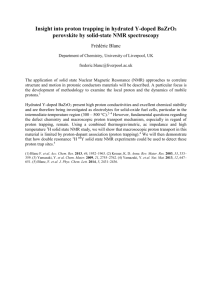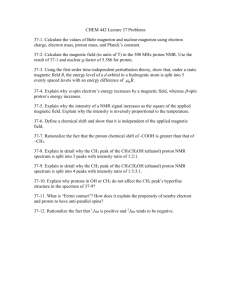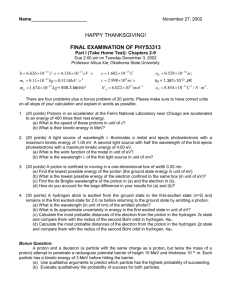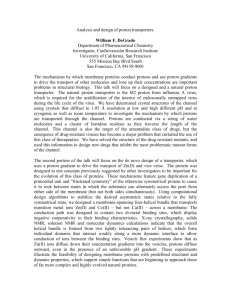Heteronuclear shift correlation spectroscopy
advertisement
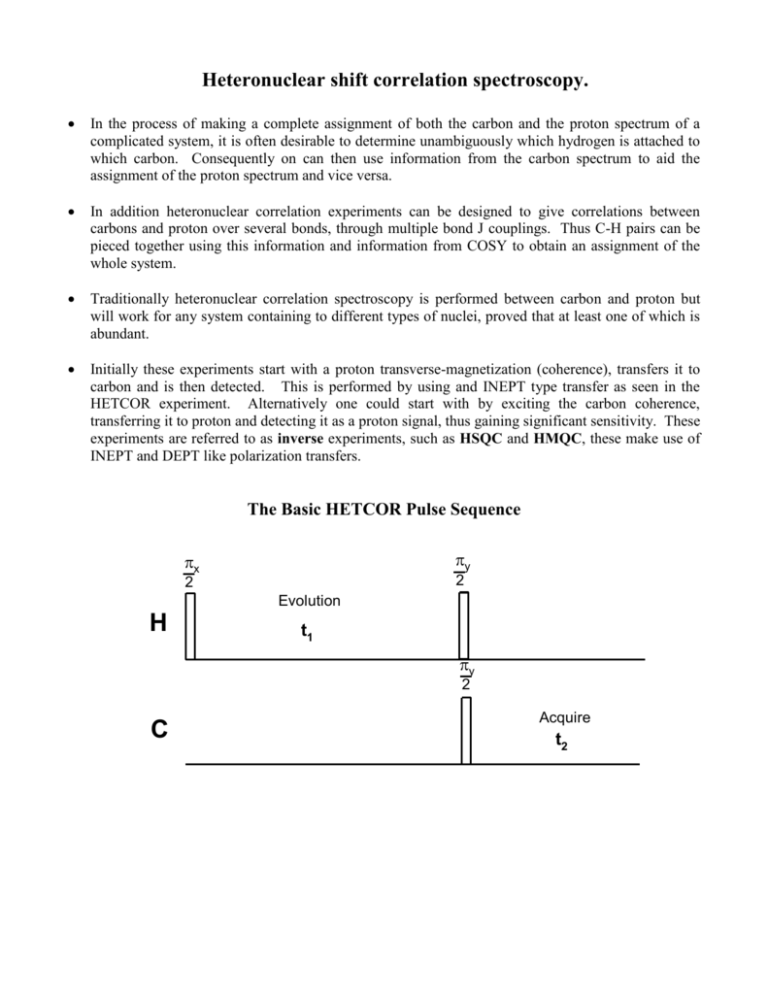
Heteronuclear shift correlation spectroscopy. In the process of making a complete assignment of both the carbon and the proton spectrum of a complicated system, it is often desirable to determine unambiguously which hydrogen is attached to which carbon. Consequently on can then use information from the carbon spectrum to aid the assignment of the proton spectrum and vice versa. In addition heteronuclear correlation experiments can be designed to give correlations between carbons and proton over several bonds, through multiple bond J couplings. Thus C-H pairs can be pieced together using this information and information from COSY to obtain an assignment of the whole system. Traditionally heteronuclear correlation spectroscopy is performed between carbon and proton but will work for any system containing to different types of nuclei, proved that at least one of which is abundant. Initially these experiments start with a proton transverse-magnetization (coherence), transfers it to carbon and is then detected. This is performed by using and INEPT type transfer as seen in the HETCOR experiment. Alternatively one could start with by exciting the carbon coherence, transferring it to proton and detecting it as a proton signal, thus gaining significant sensitivity. These experiments are referred to as inverse experiments, such as HSQC and HMQC, these make use of INEPT and DEPT like polarization transfers. The Basic HETCOR Pulse Sequence y x 2 2 Evolution H t1 y 2 C Acquire t2 This pulse sequence starts with the proton z-magnetization, which is converted to a proton ymagnetization by the 90ox pulse, which is allowed to evolve under J for t1. Keeping track of only the first term, up to this point we get: MH z 900x M H y Evolution under J C MH x Mz The second term MxHMzC is antiphase x-magnetization of proton. Now considering evolution under the proton chemical shift term: M xH M zC C.S . Evolution C M H x, y M z A( H t1, Jt1) Applying the 900 pulses in both channels, with the appropriate phase cycle give either pure x- or ycarbon-antiphase magnetization: C MH z M x A( H t1, Jt1) which will give rise to obervable signal in the carbon channel. This term evolves into an observable carbon y-magnetization during the detection period as: MCy A( H t1, Jt1 ) which evolves under the carbon chemical shift as: A( C t2 , Jt2 )MCy A( H t1, Jt1) this term has two time dependencies than on proton parameters in t1 and on carbon parameters in t2. This term gives rise to anit-phase doublet structure in both dimensions, a thus self-cancels when proton decoupling is used during detection. In order to allow for decoupling during acquisition this anti phase double needs to be refocused just like in the INEPT sequence. Consequently a refocusing delay is added at the end of the sequence terminated by a 180o pulses in both the proton and carbon channels. To remove the coupling in the proton dimension carbon decoupling is employed during t1. After the evolution period the antiphase terms is allowed to build up optimally for a period 1/2J. HETCOR Pulse Sequence Modified to Allow for Decoupling x x x 2 x 2 Evolution H t1 Decoupling x x C 1/2J Decoupling x 2 Acquire 1/2J t2 Indirectly detected heteronuclear correlation experiments Heteronuclear correlation experiment can be performed using proton detection thereby greatly increasing the sensitivity of the experiment. There are two basic approaches referred to as Heteronuclear multiple quantum coherence, or HMQC, or the Heteronuclear signal quantum coherence, or HSQC. Often HMQC is referred to as Heteronuclear multiple-bond coherence, or HMBC. The Heteronuclear Multiple Quantum Coherence Pulse sequence x 2 Acquire H t2 2 C 2 Evolution 1/2J 1/2J t1 Decoupling 1) The HMQC experiment, starts by exciting a proton y-magnetization, which evolves into an antiphase x-magnetization after a period of 1/4J under scalar coupling evolution. (proton evolution is ignored) MH z 900x ( H ) M H y Evolution under J C MH x Mz 2) This anti-phase proton x-magnetization is converted to a double quantum coherence by a pulse in the carbon channel. This DQC evolves under the both the chemical shift terms of H and C, but not the scalar coupling term. 90C y C C MH MH x M z x Mx or 90C C C x MH MH x M z x My 3) The 1800 pulse in the proton channel right at the center of the sequence serves to refocus any proton evolution up until the beginning of the detection period. Thus the DQC only acquires dependence on the carbon chemical shift during the evolution period. Evolution under C H C C M x M x A( c , t1)M H x Mx 4) At the end of the evolution period the DQC is converted back to the proton anti-phase xmagnetization, by the 900 pulse in the carbon channel. 90C y C C A( c , t1)M H A( c , t1)M H x M x x Mz 5) This proton antiphase term is refocused to a in-phase x-magnetization under the influence of the scalar coupling evolution. C A(vc , t1)M H x Mz Evolution under J A(vc , t1)M H y 6) The proton SQC is evolves only under the proton chemical shift term since carbon decoupling is employed during the acquisition period, giving: A(vc , t1)M H y Evolution under vH A(vH , t2 )M H y A(vc , t1) this term depends on the carbon chemical shift in t1 and the proton chemical shift in t2, which means that in this experiment carbon is the indirect dimension and proton the direct dimension. Again two-data set are required to be sensitive to sign and phase. This experiment is used to correlate carbons to all local proton coupled to it, through several bond. It is often referred to as the Heteronuclear Multiple Bond Correlation spectroscopy, and is one of the main work horses in 2D NMR structural studies. The peaks in the HBMX experiment have fine structure, splittings etc, in the proton dimension, this is the result of any homonuclear scalar coupling evolution during t1, which cannot be suppressed. The Heteronuclear Single Quantum Coherence Experiment. The Heteronuclear Single Quantum Coherence Spectroscopy, establishes correlation between carbon and its directly bound protons. Longer range connection are not made with this experiment. Again the cross peak do not contain fine structure due to the proton-carbon coupling since proton couplings are refocused during the evolution period and carbon decoupling is employed during detection. The experiment starts with a basic proton to carbon INEPT transfer, optimized to give a pure antiphase carbon SQC (anti-phase y-magnetization), which is allowed to evolve under the carbon chemical shift only during the evolution period (Hence the name of the sequence). At the end of the evolution period, the proton anti-phase SQC is converted to on observable carbon in-phase SQC by an carbon-proton INEPT transfer. The Heteronuclear Single Quantum Coherence Pulse Sequence x 2 H 2 y 2 x Acquire 1/2J 1/2J x C x 1/2J 2 2 1/2J t2 x Evolution Decouple t1 1) INEPT transfer from proton to carbon giving pure anti-phase proton magnetization: H toC INEPT H C MH z M z M y the phase of the carbon SQC is determined by the pulse phases, 1 and 2) The carbon anti-phase magnetization evolves over only the carbon chemical shift. Evolution due to carbon-proton J coupling is refocused by the 180o pulse in the proton channel in the center of the evolution period. C C MH MH z M y z M y A Ct1 evolution 3) At the end of the evolution period the antiphase carbon magnetization converted to an anti-phase proton coherence by the simultaneous 900 pulses in the carbon and proton channels: 90 H 90C C C x x MH MH z M y A Ct1 y M z A Ct1 4) The anti-phase proton magnetization is refocused into an in-phase proton magnetization, by the remainder of the sequence, which is just like the refocusing part in refocused INEPT sequence. Re mainder of sequence H C M y M z A Ct1 MH y A Ct1 5) Finally the proton evolves during the detection period under the influence of the proton chemical shift only since it is decoupled from carbon. Evolution under H H M y A Ct1 A Ht2 M H y A Ct1 This pulse sequence is repeated to obtain a second data set, in order to be phasable data in the indirect dimension. A Comparison Between Carbon Decoupled and Coupled HMQC Spectra. A comparison between and HSQC and an HMQC spectrum showing the difference in the cross peak structure. Example – COSY spectrum of Camphor 13 C NMR spectrum with H decoupling DEPT Spectra HSQC spectrum of Camphor HMBC Spectrum of Camphor



